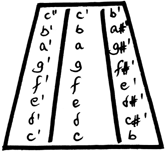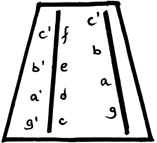fig. 49: from Tobias Stimmer (1539-1584), 'Women musicians'
CHAPTER 3: History to 1800 > Later Renaissance - 16th century
Illustrations - 8 of 10
|
fig. 49: from Tobias Stimmer (1539-1584), 'Women musicians' |
|
|
fig.
53: 'box' and 'integral' constructions |
Tobias Stimmer's Hackprett (fig.49) is remarkable for several reasons: it is the first example found of 'integral' construction, where the wrest-blocks and hitch-blocks form the sides of the instrument (as fig.53) and of pins inserted in a convex surface (at an angle of c.45° like the Evora painting).
 |
|
fig. 52a: possible tuning for Stimmer's Hackprett |
The bridging is also unusual as shown: all the strings pass over two bridges, giving three playing portions, drawn in the ratio 15:34:16. 15:16 gives approximately a major second, 16:34 a minor ninth, so that if the longest string section were tuned to c, the result would be three scales, of c, c# and d#, the central section over an octave lower than the others (fig.52a).
 |
|
fig. 52b: possible tuning for Stimmer's Hackprett |
This hardly seems a feasible 16th century tuning. A slight adjustment of the bridges would produce a semitone between the two outside parts, one of which could have been in octaves with the central portion, e.g.
fig.52b, but this result seems hardly more likely.
|
fig.
50: from Tobias Stimmer |
A comparison with the viol-player in the same series (fig.50) shows only four frets drawn, approximately equidistant, and spaced too far apart to be semitones; the fretting on the viol therefore seems unrealistic, and it may well be that such details as the bridging in the Hackprett are not more accurately depicted.
 |
|
fig. 52c: possible tuning for Stimmer's Hackprett |
If there were in fact holes in the bridge of the Hackprett, and the strings were in two planes, then the instrument would conform to the common type 11.2., with four treble courses and four bass courses (fig. 52c). If the treble strings passed through the right-hand bridge to the saddle, the ratio would be 1:3, giving an octave and a fifth rather than the more normal simple fifth: this is perhaps not totally unfeasible, when one considers that 60 years later Mersenne was describing courses tuned in octaves and fifths; but we can really do no more than guess in any event.
If the drawing were in fact true-to-life, Stimmer's dulcimer would not be the only later example of type 2, for Nierop in 1659 described another - equally enigmatic, as it happens.
|
|